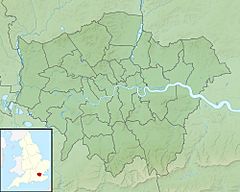Finchley Gap facts for kids
The Finchley Gap is a name for special marks left behind by ancient glaciers in North London. These marks are mostly found south of a place called Grim's Ditch. For a long time, people thought this area was a "wind gap," which is a valley made by a river that isn't there anymore. But in the 1980s, scientists found out that it was actually left by glaciers. They also learned that the River Colne, which flows west and south today, used to flow in a different direction, towards the Lea Valley!
Contents
How Ice Ages Changed Rivers
During the Ice Ages, huge sheets of ice covered much of the land. This period is called the Anglian glaciation in Britain, and it happened around 450,000 years ago. These ice sheets were so big that they blocked the paths of rivers.
Rivers Blocked by Ice
Imagine a river flowing along its usual path. When a giant ice sheet moved in, it acted like a dam. For example, the River Thames in its upper part, near the Goring Gap, got blocked. This caused water to build up, forming a huge periglacial lake.
The River Great Ouse also had its path blocked by ice. This led to a lot of ice forming in the Vale of Aylesbury.
New Paths for Water
When rivers were blocked, the water had to find new ways to flow. Sometimes, it would reverse direction. Other times, it would overflow and carve out completely new valleys. This is how the middle and lower parts of the modern River Thames got their shape.
The ice sheets also covered most of Middlesex. This meant that rivers like the River Crane and River Ash had to flow south and then east. Many smaller channels of the River Colne also formed, all eventually joining the main River Thames.
Finding Clues from the Past
Scientists have studied the ground in places like Finchley to understand what happened during the Ice Ages.
Professor Wooldridge's Discoveries
A scientist named Professor Sidney Wooldridge did a lot of important work in 1938 and 1960. He found strong evidence of glaciation in the area. He discovered special types of clay and rocks, called "boulder clays," that are left behind by glaciers.
These clues showed that the ice reached places like Bricket Wood in the northwest, Finchley in the west, and Hornchurch in the east of London. These deposits tell us how the land was worn down by the ice during the Quaternary ice age.
The Mystery of the Finchley Gap
For a while, people wondered if the Finchley Gap was a place where the River Colne might have connected to the River Brent.
Solving the Puzzle
However, later research helped scientists understand more. They compared gravel deposits from the Vale of St Albans with those found in the modern River Thames valley. This new information suggested that the idea of the Colne flowing through Finchley was unlikely.
Instead, it seems that when the Colne was blocked by ice near Rickmansworth, it overflowed more directly into its current path. The valleys of streams like the Mutton Brook, Dollis Brook, and River Brent were probably carved out by water melting from the huge glacier that covered Finchley.


